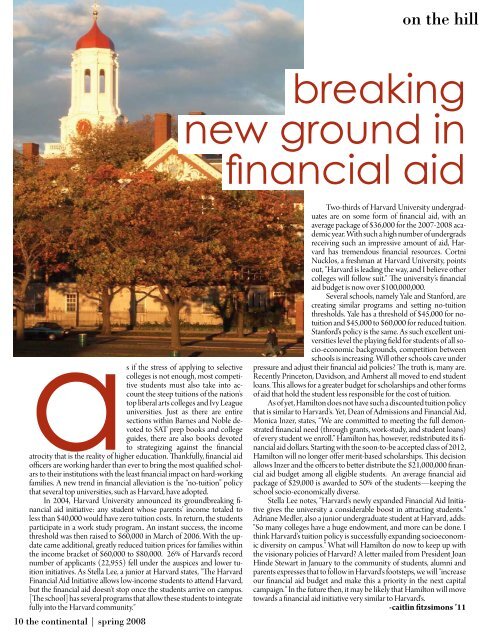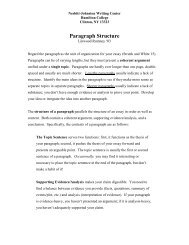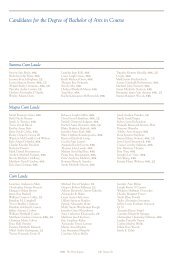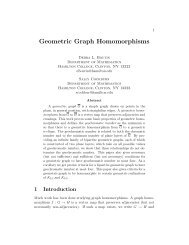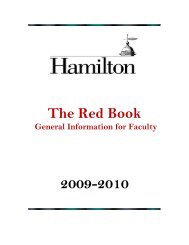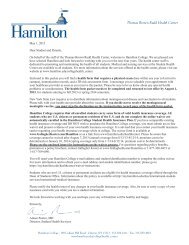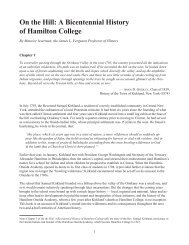The Continental - Hamilton College
The Continental - Hamilton College
The Continental - Hamilton College
Create successful ePaper yourself
Turn your PDF publications into a flip-book with our unique Google optimized e-Paper software.
on the hillbreakingnew ground infinancial aidas if the stress of applying to selectivecolleges is not enough, most competitivestudents must also take into accountthe steep tuitions of the nation’stop liberal arts colleges and Ivy Leagueuniversities. Just as there are entiresections within Barnes and Noble devotedto SAT prep books and collegeguides, there are also books devotedto strategizing against the financialatrocity that is the reality of higher education. Thankfully, financial aidofficers are working harder than ever to bring the most qualified scholarsto their institutions with the least financial impact on hard-workingfamilies. A new trend in financial alleviation is the “no-tuition” policythat several top universities, such as Harvard, have adopted.In 2004, Harvard University announced its groundbreaking financialaid initiative: any student whose parents’ income totaled toless than $40,000 would have zero tuition costs. In return, the studentsparticipate in a work study program.. An instant success, the incomethreshold was then raised to $60,000 in March of 2006. With the updatecame additional, greatly reduced tuition prices for families withinthe income bracket of $60,000 to $80,000. 26% of Harvard’s recordnumber of applicants (22,955) fell under the auspices and lower tuitioninitiatives. As Stella Lee, a junior at Harvard states, "<strong>The</strong> HarvardFinancial Aid Initiative allows low-income students to attend Harvard,but the financial aid doesn't stop once the students arrive on campus.[<strong>The</strong> school] has several programs that allow these students to integratefully into the Harvard community."10 the continental | spring 2008Two-thirds of Harvard University undergraduatesare on some form of financial aid, with anaverage package of $36,000 for the 2007-2008 academicyear. With such a high number of undergradsreceiving such an impressive amount of aid, Harvardhas tremendous financial resources. CortniNucklos, a freshman at Harvard University, pointsout, "Harvard is leading the way, and I believe othercolleges will follow suit." <strong>The</strong> university’s financialaid budget is now over $100,000,000.Several schools, namely Yale and Stanford, arecreating similar programs and setting no-tuitionthresholds. Yale has a threshold of $45,000 for notuitionand $45,000 to $60,000 for reduced tuition.Stanford’s policy is the same. As such excellent universitieslevel the playing field for students of all socio-economicbackgrounds, competition betweenschools is increasing. Will other schools cave underpressure and adjust their financial aid policies? <strong>The</strong> truth is, many are.Recently Princeton, Davidson, and Amherst all moved to end studentloans. This allows for a greater budget for scholarships and other formsof aid that hold the student less responsible for the cost of tuition.As of yet, <strong>Hamilton</strong> does not have such a discounted tuition policythat is similar to Harvard's. Yet, Dean of Admissions and Financial Aid,Monica Inzer, states, “We are committed to meeting the full demonstratedfinancial need (through grants, work-study, and student loans)of every student we enroll.” <strong>Hamilton</strong> has, however, redistributed its financialaid dollars. Starting with the soon-to-be accepted class of 2012,<strong>Hamilton</strong> will no longer offer merit-based scholarships. This decisionallows Inzer and the officers to better distribute the $21,000,000 financialaid budget among all eligible students. An average financial aidpackage of $29,000 is awarded to 50% of the students—keeping theschool socio-economically diverse.Stella Lee notes, "Harvard's newly expanded Financial Aid Initiativegives the university a considerable boost in attracting students."Adriane Medler, also a junior undergraduate student at Harvard, adds:"So many colleges have a huge endowment, and more can be done. Ithink Harvard's tuition policy is successfully expanding socioeconomicdiversity on campus." What will <strong>Hamilton</strong> do now to keep up withthe visionary policies of Harvard? A letter mailed from President JoanHinde Stewart in January to the community of students, alumni andparents expresses that to follow in Harvard's footsteps, we will "increaseour financial aid budget and make this a priority in the next capitalcampaign." In the future then, it may be likely that <strong>Hamilton</strong> will movetowards a financial aid initiative very similar to Harvard's.-caitlin fitzsimons ’11


